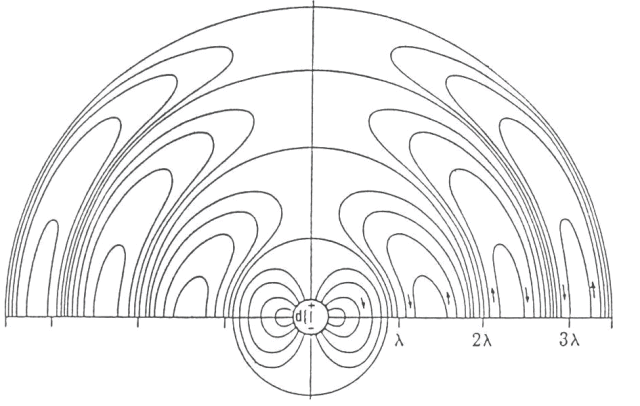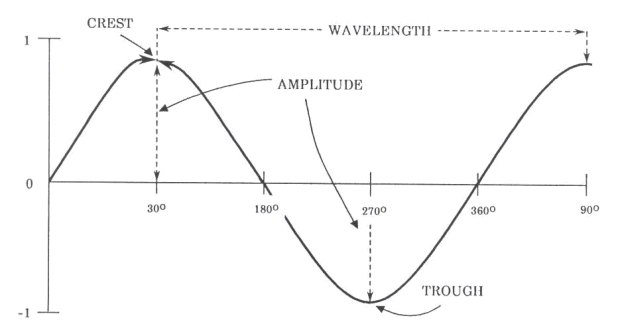The electromagnetic field is a physical field produced by electrically charged objects. It affects the behavior of charged objects in the vicinity of the field.
The electromagnetic field extends indefinitely throughout space and describes the electromagnetic interaction. It is one of the four fundamental forces of nature (the others are gravitation, the weak interaction, and the strong interaction).
The field can be viewed as the combination of an electric field and a magnetic field. The electric field is produced by stationary charges, and the magnetic field by moving charges (currents); these two are often described as the sources of the field. The way in which charges and currents interact with the electromagnetic field is described by Maxwell's equations and the Lorentz Force Law.
From a classical point of view, the electromagnetic field can be regarded as a smooth, continuous field, propagated in a wavelike manner, whereas from a quantum mechanical point of view, the field can be viewed as being composed of photons.
Weather radars transform electrical energy into electromagnetic energy by rapidly varying the polarity of an electric dipole. As shown in the figure below, an electric dipole consists of two equal and opposite charges, + and -, separated by a vary small distance. As the polarity is varied, the electric field around the dipole changes. Electric charges in motion induce a magnetic field which induces another electrical field at a greater distance. This process leads to a propagation of the electromagnetic field away from the electric dipole at approximately 3×108 m/sec, or c (speed of light). Therefore, an electromagnetic field actually consists of two coupled fields: the electric field and the magnetic field. These fields will be examined further in the section covering polarization.
Electrical field around an oscillating dipole
As previously stated, weather radars transmit electromagnetic energy into space. This energy propagates in the form of waves. A basic understanding of terms which define a given waveform is required of all radar operators. Referring to the figure below, the wavelength, λ, is the distance between successive crests or troughs. The characteristic of electromagnetic radiation that is most often referred to by meteorologists and meteorological technicians is the wavelength employed by a given radar. In meteorology wavelengths are typically expressed in centimetres.
Electrical field around an oscillating dipole
The time it takes electromagnetic radiation to propagate from one crest to the next (that is, to complete one cycle) is equal to one period, T, typically expressed as some potion of a second. The frequency, f, of the wave refers to the number of cycles the electromagnetic energy propagates through per unit time, and is the reciprocal of the period; f=1/T. Frequency is expressed in units of hertz (Hz). One hertz is equal to one cycle per second.
Amplitude is related to energy. The larger the amplitude the greater the power associated with a wave. Peak or maximum power occurs at the apex (crest and trough) of the wave, so amplitude represents the peak power transmitted. Referring the Figure 2, amplitude (and therefore peak power) maximizes at 90 and 270 degrees from the origin of the sine wave.
Electromagnetic energy is characterized by electrical and magnetic fields which are perpendicular to each other and to the direction of propagation of the energy (waves). Referring to the figure below, it is apparent that at some distance from the radar, the electric field and magnetic field are in phase but are at right angles to each other. The wave surface is defined by the location and orientation of the electric and magnetic field vectors. Note also the orientation of the electric field and magnetic field vectors with respect to the direction of propagation of the electromagnetic energy. Again, all these vectors are at right angles to the propagation vector.
Components of electromagnetic waves. In this example, the electric field, denoted by E, is in the X-Z plane, the magnetic field, denoted by M, is in the X-Y plane, and the electromagnetic energy is propagating in the X direction at the speed of light (c).
Applications
Properties of the electromagnetic field are exploited in many areas of industry. The use of electromagnetic radiation is seen in various disciplines. For example, X-rays are high frequency electromagnetic radiation and are used in radio astronomy, radiography in medicine and radiometry in telecommunications. Other medical applications include laser therapy, which is an example of photo-medicine. Applications of lasers are found in military devices such as laser-guided bombs, as well as more down to earth devices such as barcode readers and CD players. Something as simple as a relay in any electrical device uses an electromagnetic field to engage or to disengage the two different states of output (ie, when electricity is not applied, the metal strip will connect output A and B, but if electricity is applied, an electromagnetic field will be created and the metal strip will connect output A and C).


